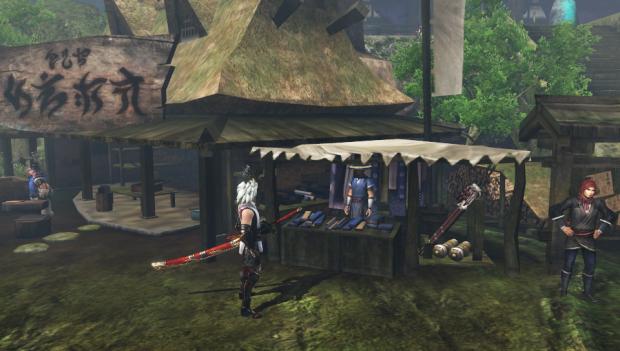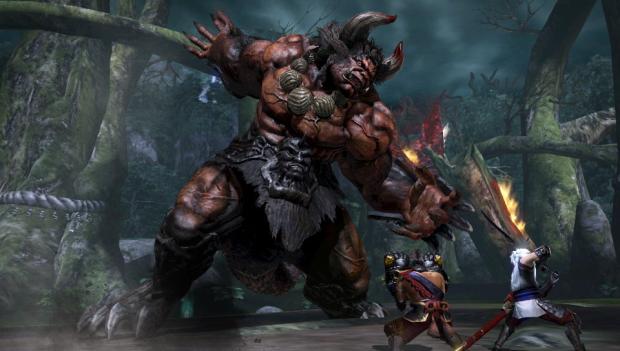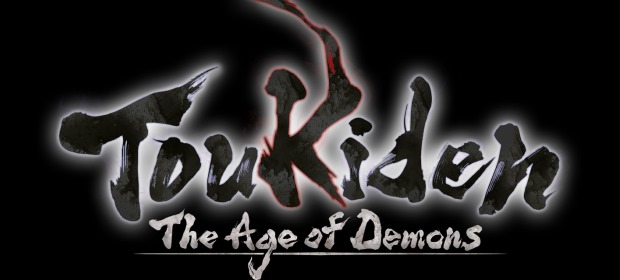I could start this review with some spiel about imitation being the sincerest form of flattery, but ultimately that’s just a fancy way of saying “this game rips off that game”, which, in the case of Toukiden: The Age of Demons is only mostly true and not entirely fair. There’s no way to avoid staring at the big grey pachyderm eating biscuits in the lounge, though: Toukiden is a gestalt entity, not created from a single original ingredient but instead assembled from bits and pieces of Monster Hunter and Soul Sacrifice.
The plot focuses on a group of demon hunters called Oni Slayers, who exist purely to kill demons that cross over into the mortal world. Your character is a new recruit who signs up on the cusp of a significant shift in Oni behaviour. Bigger demons are appearing more frequently and the smaller ones are getting bolder, attacking settlements across the land. One such settlement is Utakata village, to which you are assigned, and it is hereth that the fate of the world shall be decidedeth. Yes, pigeon Shakespeare is an occasional issue in the writing, but at least it gives you something to smile at, verily.

The village acts as a hub in a similar fashion to Monster Hunter. You take quests at a desk in the headquarters, or you can visit the sparse smattering of shops, head home to customise your avatar or bathe in the communal pool, which confers a bonus for the next mission and seems to only exist to facilitate lines of text like “You bathed with Oka!”.
Missions come in a variety of flavours, which all boil down to navigating an exact replica of a Monster Hunter map to kill demon after demon until either the mission parameters are met or a boss appears. You can lock on and evade, and each of the six weapon types on offer come with their own attacks and special moves. Similarly to Soul Sacrifice, special abilities have a limited number of uses which must be replenished at special fonts found in-battle, which can only be seen using a spirit vision mode. It makes for some tense moments when your powers are running low and the boss you’re fighting is still going strong.

It’s these boss encounters that make Toukiden interesting. They’re huge beasts that require ritual dismemberment to vanquish. Lop off a limb and you can do damage to the spirit previously housed within that limb. The severed appendage itself will lie on the battlefield, and only by using the Ritual of Purification (holding down R) can you prevent the boss from regenerating. This is also how you loot, so you’ll get used to Purifying everything you leave bleeding on a battlefield between attacks and evasions. Handily, should you find yourself too busy to scavenge through the pockets of dead demons, your AI allies (assembled from a fairly likeable pool of JRPG clichés) will purify enemies for you, bless them.
Special powers are drawn from Mitama, the souls of dead Slayers freed from the demons who ate them centuries before. There are 8 types, ranging from Attack through Defence, Spirit, Deceit and Luck – among others. Each type allows the use of three unique abilities and a fourth, Recovery (which heals you for a percentage of your life). Abilities vary between attacks, buffs, debuffs, and AoE damage, and after a few hours you’ll be able to equip more than one Mitama, combining their passive buffs for powerful boosts.

If an elephant in your lounge is less upsetting to you when it’s juggling and riding a unicycle, you’re in luck, because while Toukiden is dangerously derivative at times, it’s also incredibly good fun. Not as po-faced as its contemporaries, it asks you to kill, kill, and kill some more, while looting hundreds of items to use in crafting new armour and weapons. Another borrowed mechanic, the crafting feels a little underdeveloped and doesn’t offer the immense variety it could (seriously, there is a stupid number of lootable materials to be found), and instead asks that you give over most of what you find to complete “quests”, the majority of which fall into the “fetch and carry” category and only reward you with more money, or a bigger storage area.
Graphically, Toukiden is pretty enough, but the aesthetic is another overly familiar aspect and nothing to raise pulses. Character models are at least detailed, and the CGI cutscenes are smooth and well-made. The audio, on the other hand, is a question of taste. All the voice work is in Japanese, and the music is the same repetitive mix of twinkly strings and out-of-place rock we’ve come to expect.

If you get bored of stalking demons alone, you can swap out your AI party with real players in the online and ad-hoc multiplayer mode. Unsurprisingly, this improves things considerably, as you’re now able to use skills and buffs as a team to take down some of the tougher enemies and grind for those all important rare crafting materials. The multiplayer, on the surface, is very similar to the solo game, but you can’t beat a bit of teamwork.
VERDICT: You might think it’s safe to say that if you like Monster Hunter and Soul Sacrifice then you’ll like Toukiden, but in fact Tecmo Koei’s game is likely to appeal to a wider audience, though perhaps on a less cult-y level. The universe and premise may not be particularly original, but Toukiden offers a simple and addictive template that’s every bit as fun and playable as, say, Ragnarok Odyssey.
If you don’t go in expecting something groundbreaking, there’s a lot to like here, the simple elegance of the button-mashy combat and the broad range of skills and weapons offering enough variety to keep things fresh throughout an impressively-sized campaign. Overall, Toukiden is a bit of a triumph for Tecmo, whose flagship franchises – while successful – are often (rightly) accused of following staid templates. Toukiden deviates from their own formula, at least, even if it does borrow a lot of elements from elsewhere in order to craft a new one. Not a classic, but certainly well worth picking up by fans of Eastern Action-RPGs in general.

GOOD. A game that scores 7/10 is worthy of note, but unworthy of fanfare. It does many things well, but only a few of them incredibly well and, despite a handful of good qualities, fresh ideas and solid mechanics, it fails to overwhelm.
Review code provided by publisher.





